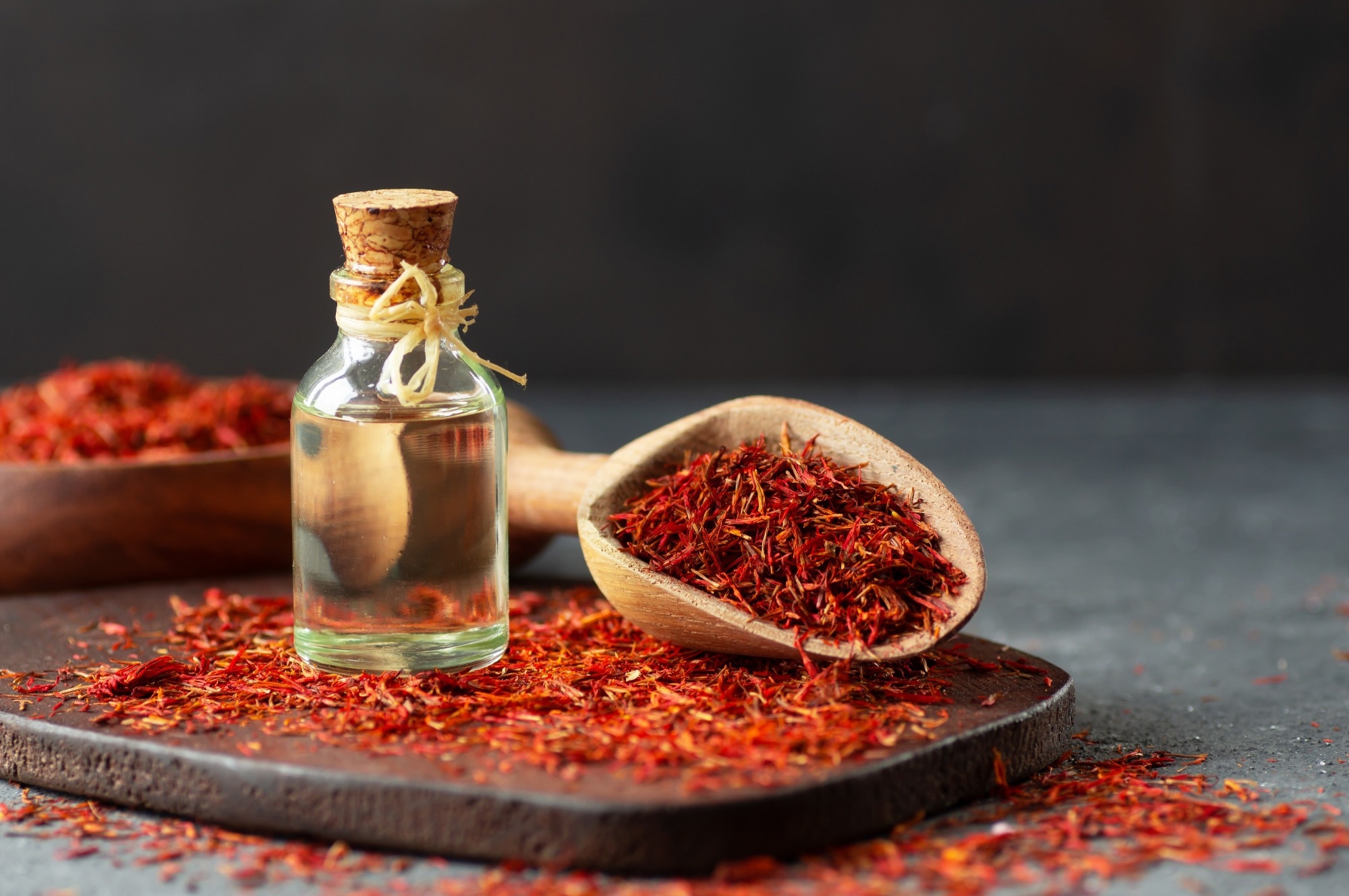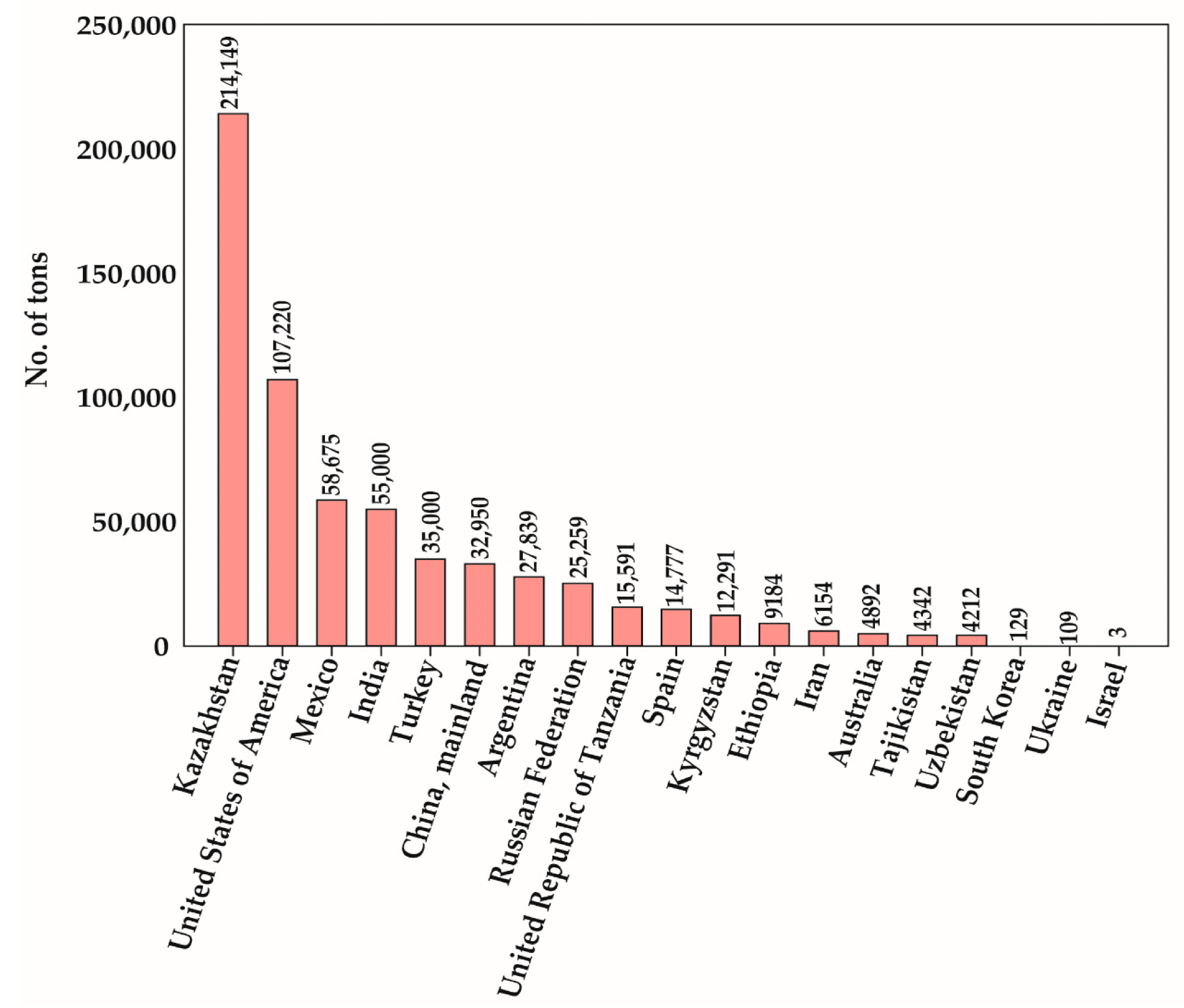Introduction
Cardiovascular and lipid health
Metabolic health and blood sugar regulation
Skin and inflammatory conditions
Immune-modulating and anti-inflammatory effects
Additional health benefits
Safety, dosage, and usage considerations
Conclusions
References
Further reading
Safflower oil, derived from Carthamus tinctorius, provides cardiovascular, metabolic, skin, and antimicrobial benefits through its rich composition of linoleic, oleic acids, tocopherols, and phenolics. Traditional and modern studies highlight its roles in lipid regulation, glycemic control, barrier repair, and the potential therapeutic effects of safflower yellow pigments.
 Image Credit: Halil Ibrahim Mescioglu / Shutterstock.com
Image Credit: Halil Ibrahim Mescioglu / Shutterstock.com
Introduction
Safflower (Carthamus tinctorius), a thistle-like plant from the Asteraceae family, has been cultivated for centuries for its seeds to produce high-quality oil, animal feed, dyes, and medicinal compounds. Traditionally, the brightly colored florets of safflower were used to color and flavor food and textiles before synthetic dyes emerged.
Safflower grows in dry, hot climates and in over 60 countries throughout the world, with Kazakhstan, the United States, Mexico, India, Turkey, and China among the top producers. Modern research highlights the rich chemical profile of flavonoids, fatty acids, and antioxidants, which has renewed scientific interest in the potential cardiovascular, anti-inflammatory, and metabolic health benefits of safflower oil. Safflower exists in two major oil chemotypes: high-linoleic (about 75–80% linoleic acid, ~10–15% oleic acid) and high-oleic (about 75–80% oleic acid, ~10–15% linoleic acid), which differ in health effects and cooking stability.1

List of the world’s top safflower-producing countries in 2018. The total production value for each country is shown in the graph. The country-wise production statistics were obtained from FAOSTAT (2020) [9], while the production value of South Korea was obtained from the database of the Ministry of Agriculture, Food and Rural Affairs, Korea.1
Cardiovascular and lipid health
Safflower oil is largely unsaturated, with composition varying by cultivar: high-linoleic types are rich in omega-6 linoleic acid, while high-oleic types are rich in omega-9 oleic acid, which supports favorable functional properties. Safflower oil is rich in phenolic compounds, flavonoids, and tocopherols, and whole safflower seeds provide ~15–22% protein and ~11–22% fiber.
Linoleic acid, the primary omega-6 polyunsaturated fatty acid (PUFA) present in many seed oils, supports cardiovascular health by reducing low-density lipoprotein (LDL) cholesterol levels, thereby improving the total-to-high-density lipoprotein (HDL) cholesterol ratio. Linoleic acid can also yield bioactive metabolites that enhance insulin sensitivity and reduce low-grade inflammation, both of which protect cardiovascular health.3
Oleic acid, an omega-9 monounsaturated fatty acid (MUFA), especially abundant in high-oleic safflower oil, complements these benefits through vascular effects. Diets rich in oleic acid are associated with lower blood pressure by improving endothelial function, membrane fluidity, and nitric oxide (NO) bioavailability, as well as reduced oxidative stress.

Differential flowering phenotypes of Carthamus tinctorius L.: (A) Yellow (The Germplasm Resources Information Network database, PI251398), (B) red (PI253529), and (C) white (PI209297).1
Metabolic health and blood sugar regulation
In a randomized, double-masked crossover trial of obese post-menopausal women with type 2 diabetes, 8.0 g/day of safflower oil for 16 weeks lowered glycated hemoglobin (HbA1c) levels by 0.64%. Improved insulin sensitivity and reduced fasting glucose were also reported after about 16 weeks of this intervention. The improvements were time-dependent: HbA1c and fasting glucose effects appeared after 16 weeks, while HDL rose after 12 weeks.
HDL cholesterol levels rose by 0.12 mmol/L after 12 weeks, whereas C-reactive protein (CRP) levels decreased, thus suggesting anti-inflammatory effects.4 Increased lean mass and reduced trunk fat were also reported, which aligns with improvements in glucose regulation and inflammation, as visceral adiposity is closely linked to insulin resistance and metabolic syndrome features.
Comparatively, conjugated linoleic acid (CLA) led to small weight and fat-mass losses without providing a significant improvement in glycemia, insulin sensitivity, lipids, or inflammation. Animal studies also suggest safflower oil can reduce abdominal adiposity in exercise-trained rats, though without major effects on glucose or lipid levels.4,9
Skin and inflammatory conditions
Topical safflower oil acts as an emollient that reinforces the stratum corneum barrier, supporting the ability of skin to retain moisture by reducing transepidermal water loss and improving hydration. These effects are attributed to the high linoleic acid content of safflower oil, which maintains the epidermal water-permeability barrier.
The major cutaneous metabolite of linoleic acid, 13-hydroxyoctadecadienoic acid, has anti-proliferative activity relevant to inflamed skin. In eczema or atopic dermatitis, restoring barrier hydration and reducing transepidermal water loss are key therapeutic goals, which indicates the potential utility of topical safflower oil for providing barrier repair to potentially limit progression.5
Safflower also provides anti-inflammatory phytochemicals like luteolin and its glucosides, which inhibit nuclear factor kappa-B signaling. Tocopherols like vitamin E and phenolics also modulate barrier homeostasis and inflammation to support its integrity and repair.
Ultraviolet exposure generates reactive oxygen species (ROS) that degrade dermal collagen and trigger photo-oxidative inflammation. Antioxidant-rich oils have the potential to overcome these reactions while preserving collagen during skin repair.5
In addition to Streptococcus agalactiae, studies confirm antimicrobial activity against Staphylococcus aureus, a clinically important skin pathogen.7
Safflower Oil: The Complete Guide to Healthy Cooking Oils
Immune-modulating and anti-inflammatory effects
Safflower oil itself contains negligible omega-3 fatty acids (EPA, DHA); its bioactivity is mediated mainly by omega-6 linoleic acid and derivatives. The following mechanisms describe general PUFA biology rather than the direct effects of safflower oil. Omega-3 long-chain PUFAs like docosahexaenoic acid (DHA) and eicosapentaenoic acid (EPA) activate peroxisome proliferator-activated receptors, which suppress nuclear factor kappa-B-linked cytokine production. Aspirin-acetylated cyclooxygenase also promotes the conversion of DHA/EPA into resolvins and neuroprotectins that actively resolve inflammation.
In microglia and other immune cells, omega-3 long-chain PUFAs downregulate lipopolysaccharide-stimulated tumor necrosis factor α (TNF-α) and interleukin-6 (IL-6). Specialized pro-resolving mediators such as resolvin D1 can further enhance alternative activation programs relevant to reduced chronic inflammation.
Collectively, these mechanisms translate into broad anti-inflammatory potential across tissues for the management of chronic inflammation-related disorders, including neuroinflammatory states where microglial polarization is directly linked to outcomes.6
Additional health benefits
Cold-pressed seed oil exhibits broad antimicrobial activity against Escherichia coli, Enterobacter cloacae, and Streptococcus agalactiae, as well as yeasts like Candida parapsilosis and Candida sake. The antifungal potential of safflower oil has also been explored against Aspergillus niger, Penicillium digitatum, and Fusarium oxysporum.
Through bacteriostatic/bactericidal pathways, including those affecting lysozyme activity, the phenolics and PUFAS of safflower oil disrupt microbial formation to prevent fungal spore germination.7,8
Hepatoprotective and mild anticoagulant properties are also reported for safflower yellow (SY) constituents. Comparatively, hydroxysafflor yellow A (HSYA) improves nonalcoholic fatty liver in high-fat diet rat models through sirtuin-1 (Sirt1) signaling.
SY inhibits platelet aggregation, may prolong clotting time, and enhances fibrinolysis. Clinically, HSYA exhibits anticoagulant effects and has shown synergistic benefit with low-molecular-weight heparin calcium.7,8
Preclinical studies also suggest HSYA has neuroprotective and anti-cancer potential, though these require further clinical validation.8
Traditionally, safflower is used to regulate menstruation and relieve gynecologic pain, including amenorrhea and menorrhagia, thereby supporting a role in reproductive health.7,8
 Image Credit: Aleksandr Porvatkin / Shutterstock.com
Image Credit: Aleksandr Porvatkin / Shutterstock.com
Safety, dosage, and usage considerations
Used in normal culinary amounts, safflower oil is generally well tolerated. Start with small portions and keep total fat within daily limits; for supplements, human-equivalent intakes in studies are in the gram range, but individualized dosing should follow a clinician's advice. People on anticoagulants, antiplatelet drugs, or with bleeding disorders should avoid high intakes and monitor for bruising or prolonged bleeding. Cold-pressed extra-virgin oil should be used for salads and low-heat dishes to preserve tocopherols and phenolics.
Refined, high-oleic varieties should be reserved for high-heat cooking because of greater oxidative/frying stability.3 These products, which should be stored in a cool, dark place, should be immediately discarded in the event that the oil smells rancid when opened.
Conclusions
Safflower oil and seeds present a nutrient-dense profile, rich in unsaturated fats, vitamin E, and bioactive phenolics, all of which improve lipids, glycemic indices, and skin barrier function. These benefits reflect centuries of traditional use and a growing body of clinical evidence, supporting prudent culinary use within balanced, diverse diets worldwide.
References
- Mani, V., Lee, S. K., Yeo, Y., & Hahn, B. S. (2020). A metabolic perspective and opportunities in pharmacologically important safflower. Metabolites 10(6). DOI:10.3390/metabo10060253, https://www.mdpi.com/2218-1989/10/6/253
- Sarkar, M. S. U., Saha, B. K., Kabir, M. A., et al. (2025). Fatty acid profile, antioxidant capabilities and Physico-chemical assessment of functional oils from safflower seeds: A potential source in Bangladesh. Results in Chemistry 15. DOI:10.1016/j.rechem.2025.102235, https://www.sciencedirect.com/science/article/pii/S2211715625002188
- Jackson, K. H., Harris, W. S., Belury, M. A., et al. (2024). Beneficial effects of linoleic acid on cardiometabolic health: an update. Lipids in Health and Disease 23(1). DOI:10.1186/s12944-024-02246-2, https://lipidworld.biomedcentral.com/articles/10.1186/s12944-024-02246-2
- Asp, M. L., Collene, A. L., Norris, L. E., et al. (2011). Time-dependent effects of safflower oil to improve glycemia, inflammation and blood lipids in obese, post-menopausal women with type 2 diabetes: a randomized, double-masked, crossover study. Clinical Nutrition 30(4); 443-449. DOI:10.1016/j.clnu.2011.01.001, https://www.sciencedirect.com/science/article/abs/pii/S0261561411000021
- Lin, T. K., Zhong, L., & Santiago, J. L. (2018). Anti-inflammatory and skin barrier repair effects of topical application of some plant oils. International Journal of Molecular Sciences 19(1). DOI:10.3390/ijms19010070, https://www.mdpi.com/1422-0067/19/1/70
- Coniglio, S., Shumskaya, M., & Vassiliou, E. (2023). Unsaturated fatty acids and their immunomodulatory properties. Biology 12(2). DOI:10.3390/biology12020279, https://www.mdpi.com/2079-7737/12/2/279
- Khémiri, I., Essghaier, B., Sadfi-Zouaoui, N., & Bitri, L. (2020). Antioxidant and antimicrobial potentials of seed oil from Carthamus tinctorius L. in the management of skin injuries. Oxidative Medicine and Cellular Longevity. 2020(1). DOI:10.1155/2020/4103418, https://onlinelibrary.wiley.com/doi/10.1155/2020/4103418
- Chen, Y., Li, M., Wen, J., et al. (2022). Pharmacological activities of safflower yellow and its clinical applications. Evidence‐Based Complementary and Alternative Medicine 2022(1). DOI:10.1155/2022/2108557, https://onlinelibrary.wiley.com/doi/10.1155/2022/2108557
- da Silva Pérez, E. M., de Alencar, N. M. N., de Figueiredo, I. S. T., et al. (2022). Effect of safflower oil (Carthamus tinctorius L.) supplementation in the abdominal adipose tissues and body weight of male Wistar rats undergoing exercise training. Food Chemistry: Molecular Sciences 4. DOI:10.1016/j.fochms.2022.100083, https://www.sciencedirect.com/science/article/pii/S2666566222000119
Further Reading
Last Updated: Aug 24, 2025